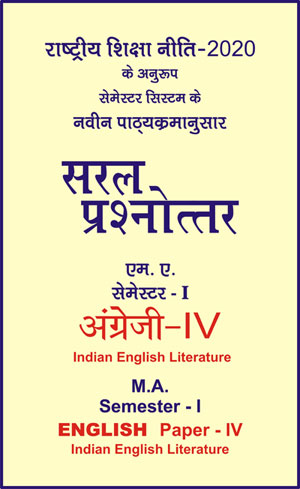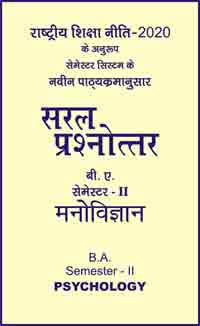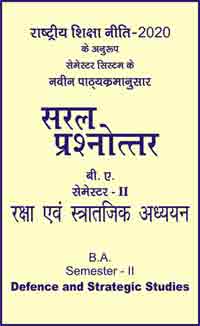|
बी ए - एम ए >> एम ए सेमेस्टर-1 - अंग्रेजी - चतुर्थ प्रश्नपत्र - इण्डियन इंगलिश लिटरेचर एम ए सेमेस्टर-1 - अंग्रेजी - चतुर्थ प्रश्नपत्र - इण्डियन इंगलिश लिटरेचरसरल प्रश्नोत्तर समूह
|
5 पाठक हैं |
|||||||
एम ए सेमेस्टर-1 - अंग्रेजी - चतुर्थ प्रश्नपत्र - इण्डियन इंगलिश लिटरेचर
Question- What are the main features of Raja Rao's narrative technique in Kanthapura?
Answer -
Raja Rao presents the story of Kanthapura as a sthalapurana in English coloured by the regional idiom of South India. The narrative that he offers recalls a visionary experience. The narrator of the story, Achakka having herself gone through it all, is reliving in memory an unforgettable experience of the heroism and tragedy of the entire village. Since Kanthapura is a novel of memory, Raja Rao freely uses reflection, dream flash-back, reminescence and narration of inter-connected episodes. Rejecting the stream of consciousness technique he employs the local form of the narration, which is a kind of non-stop, breathless style of story-telling. Starting with an account of the village and its surroundings, the narrator passes on to introducing the main characters, and straightaway plunges into describing how the Gandhian Satyagraha movement came to the village and what repercussions it had on the village community. From the beginning to the end, it is a non-stop emotion-packed narration that is bound to touch the heart of the reader.
Raja Rao's narrative act retains the nature Indian flavour inspite of his using the foreign medium of English. The narrator has an easy manner of presentation without being in any way uneasy, awkward or self-conscious. Her language suffers from no distortion even though it belongs to the Indian situation and absorbs the Indian manner of speech and gesture. The peculiarities of narrative act are in tune with the complexity of the experience that it presents. The indomitable and unwavering spirit of the Satyagrahis is projected in an enduring narrative of the Indian experience. The reader of Kanthapura participates in the breathless action from the beginning to the end.
Raja Rao's narrative act in Kanthapura consciously represents the reality in its descriptions of the setting. The digressions in which he indulges from time to time help to fill the gaps in the story and also provide some breathing space to the reader. In the detailed description of the Skeffington Coffee Estate, the elaborate digression on the Indian poisonous snakes is perhaps presented for the information of the non-Indian Western readers. The legend of Goddess Kenchamma is, on the other hand, deliberately given at the beginning to set the tune of a sthalapurana. Through subtle changes in the narrative technique, from time to time, the focus of the novel is shifted, now narrowed down to the village, now broadened to include the whole of India.
The distinctive touch of Raja Rao's technique at the beginning of the novel is to give a wealth of detail about the location, the village, its various quarters, and the prominent people living there. Without waiting time over a lengthy introduction, he quickly draw the reader's attention into the activities of the villagers and their inter-relations. He employs a very intimate way of individualizing them by referring to the peculiarities of their houses, calling or mannerisms. In this way, the author fixes the reader in the living would of a South Indian village at a definite point of time.
Raja Rao's telling of the story of Kanthapura is at the level of a mythical plane. The continuous flow of the monologue of the narrator is particularly seated for psychological analysis of characters and their motives. The uninterrupted monologue initiates the flow of speech, and helps to reveal the different level of consciousness of the village community, including that of Moorthy. Raja Rao's narrative style in Kanthapura accommodates descriptive and dramatic modes, thereby he maintains the interest of the readers and avoids monotory.
It is also seen that Raja Rao is quite successful in making his kind of Indian English 'an authentic basis for imaginative writing'. Kanthapura has a vitality of language and style which comes from the author's ability to put into practice the literary principles outlined by him in the forward of the novel. The appropriateness of his narrative technique is established by the life story of Gandhi as total by Jayaramachar, the Harikathaman, at the end of the first chapter of the novel.
Raja Rao's understanding of the folk psyche and his skill in undering this understanding artistically is a genuine quality of Kanthapura that has the appeal of a novelty to the Western readers. Quite easily, he mingles popular superstition with metaphysical institution to present the belief of the villagers in Goddess Kenchamma's power of intervention in human affairs. Their unshakeable faith in the ancient sayings and the relevance that these have to the present, project the idea of a hereditary fate.
|
|||||
- Question- Write about Post-Colonial Indian writings in English Literature?
- Question- What is Postmordanism in English Literature?
- Question- Write an essay Postmoderism's influence of Indian writing in High Ab Han English Literature?
- Question- What is Dalit Literature?
- Question- Write about Dalit's voice: A voice from the Margin?
- Question- Write the development of Indian English Poetry, since the 1980s.
- Question- What is experimental Theatre?
- Question- What is Indians in Indian "English Literature”?
- Question- Define the term 'Indian English Literature'?
- Question- What is contemporary poetry in English Literature?
- Question- What is India drama in English Literature?
- Question- What is experimental Poetry?
- Question- Write about the origin of structuralism and Post-structuralism.
- Question- Write the theory of Post-modernism.
- Question- What do understand by the post-colonialism?
- Question- Write the influence of Postmoderanism on English Literature?
- Question- Write about the Renaissance in India and other essays on Indian culture.
- Question- Write about Renaissance in India and the nature of India culture as explicated by Sri Aurobindo.
- Question- Who is Sri Aurobindo? Give an introduction of him.
- Question- What are the ideas on Indian culture of Aurobindo, given in his essay 'Indian culture and external influence'?
- Question- Write an introduction of Dr. Sarvepalli Radhakrishnan. with whole life.
- Question- What is Idealism?
- Question- Write an introduction of 'An Idealist View of Life' by Radhakrishnan.
- Question- How does an idealist view life?
- Question- Write an introduction of Nirad C. Chaudhari.
- Question- Write the background of the book 'A passage to England' by C. Chaudhari.
- Question- Write a summary of 'A Passage to England' with giving an introduction of book. and describe 'The English Scene'.
- Question- What is the purpose of Chaudhari to write 'A Passage to England?
- Question- Write a short note on the life and works of Mrs. Meenakshi Mukherjee.
- Question- What do you know about The Perishable Empire : Essays on Indian writing in English' by Meenakshi Mukherjee?
- Question- Critically appreciate the poem The Harp of India'.
- Question- Give a brief life sketch of Henry Derozio.
- Question- Write a short note on Young Bengal Movement.
- Question- Provide a brief background of the poem 'The Harp of India'.
- Question- What do you know about part 1 of the poem?
- Question- What do you know about part 2 of the poem?
- Question- What impact has the prevailing conditions of the times made on India in the poem 'The Harp of India'?
- Question- Expalin with reference to the context any two of the following passeges.
- Question- Write a critical appreciation of 'Love Poem for a Wife' by A. K. Ramanujan.
- Question- In which style 'Love poem for a wife' is written? Explain.
- Question- Expalin with reference to the context any two of the following passeges.
- Question- Who is R. Parthasarathy? Write about his life and career.
- Question- What is the summary of the poem 'Exile from Homecoming"?
- Question- Write a Critical appreciation of the poem 'Exile From Homecoming'.
- Question- What has happened to poetry and why?
- Question- Why does the speaker recommend newspapers?
- Question- What is the introduction of 'Exile From Homecoming'?
- Question- Expalin with reference to the context any two of the following passeges.
- Question- What is the introduction of the poem 'Palanquin-Bearer'?
- Question- What is the critical appreciation of "The Palanquin Bearers'?
- Question- Write life and works of Sarojini Naidu.
- Question- What is the message in Palanquin Bearers by Sarojini Naidu?
- Question- What is the mood, tone and setting of the palanquin Bearers?
- Question- What is the Summary of the poem The Palanquin Bearers'?
- Question- Expalin with reference to the context following passege.
- Question- Write life and works of Shiv K. Kumar.
- Question- Write a note on Shiv K. Kumar as a poet.
- Question- Write a critical appreciation of the poem, 'Pilgrimage'.
- Question- Expalin with reference to the context following passege.
- Question- What do you know about Dom Moraes?
- Question- What is the summary of the poem "Bells for William Wordsworth".
- Question- Expalin with reference to the context following passege.
- Question- What is the summary of the poem Tribute to Papa' by Mamta Kalia?
- Question- Mamta Kalia's poem Tribut to Papa' is quest for an identy. Write about it?
- Question- Expalin with reference to the context following passege.
- Question- Explain how myth and symbolism are integral parts of Raja Rao's fictional act in Kanthapura.
- Question- What are the main features of Raja Rao's narrative technique in Kanthapura?
- Question- The three levels of action in Kanthapura-political, social and religious are all related to a unified concept of India. Discuss the structure of the novel in the light of the statement.
- Question- Provide a summary of the novel 'Kanthapura'.
- Question- What are the important themes one can find in Kanthapura?
- Question- Place Raja Rao in the context of the evolution of the Indian writing in English.
- Question- What do you know about the historical and political background of Kanthapura?
- Question- How deep and wide is the impact of Gandhi's personality and his thought on the theme of Kanthapura?
- Question- What do you know about Kanthapura and its people?
- Question- What is the significance of the Skeffington Coffee Estate in the overall account of the village in Kanthapura?
- Question- What are those qualities that go into the making of Moorthy, the central figure in Kanthapura?
- Question- What do you think of the women characters in Kanthapura? What is their role in the action of the novel?
- Question- How successful is Moorthy in leading his followers in the Satyagraha movement of the village?
- Question- Write a short essay on 'Considerations of Caste' in Kanthapura.
- Question- How successful is Achakka, the narrator in her attempt to tell the story of her village in the context of the Satyagraha movement?
- Question- Comment on some of the male character - other than Moorthy in Kanthapura.
- Question- What are some important themes in the novel 'The Guide'?
- Question- Provide a detailed character sketch of Raju (The Guide).
- Question- Can The Guide' be called a picaresque novel?
- Question- Comment on the narrative technique in "The Guide'.
- Question- Unravel the various aspects of Rosie's character in the light of the novel.
- Question- Sum up the literary elements found in the novel.
- Question- How is the concept of universality explored in the novel?
- Question- Write a short note on R.K. Narayan.
- Question- What do you know about Raju from 'The Guide'?
- Question- Give a brief character sketch of Rosie.
- Question- What importance does the town 'Malgudi' carry in most of the novel of R.K. Narayan?
- Question- Give a brief character sketch of Marco.
- Question- Write a brief character sketch of Velan.
- Question- How is title of the novel 'The Guide' appropriate?
- Question- Critically analyze the novel The Guide.'
- Question- Is Raju a transformed man by the end of the novel?
- Question- Is Velan a mere fool or a major accessory to Raju's transformation?
- Question- What roles do dharma and Karma play in the text?
- Question- What are the some important metaphors we come across after reading in the novel?
- Question- Write about the whole life of Shashi Deshpande with works.
- Question- Shashi Deshpande's craft as a novelist a study with special reference to 'That long Silence'
- Question- What is theme of the novel 'That Long Silence'?
- Question- Describe Jaya's Quest for self in "That Long Silence' by Shashi Deshpande.
- Question- What do you mean by the title of the novel 'That Long Silence'?
- Question- What is the introduction of Shashi Deshpande?
- Question- What is 'That Long Silence' about?
- Question- What is the relationship between Jaya and Mohan in the "That Long Silence'?
- Question- Who always reminds Jaya That husband is like sheltering tree?
- Question- Who is Kamat in the novel 'That Long Silence'?
- Question- What is the Indroduction of Firdaus Kanga's 'Trying to Grow'?
- Question- Analysis of Trying to Grow' by Firdaus Kanga.
- Question- Describe of Parsi Community in "Trying to Grow' by Firdaus Kanga?
- Question- Who is Firdaus Kanga?
- Question- What is the major achievement of 'Firdaus Kanga'?
- Question- Write about the sixth Happiness, BFI/BBC Film in 'Trying to Grow' by Firdaus Kanga.
- Question- Write life and works of Arundhati Roy.
- Question- How has Arundhati Roy projected the illicit or incestuous relations in 'The God of Small Things'?
- Question- Evaluate The God of Small Things' as a tale of confrontation as its theme.
- Question- Give a brief character sketch of Estha and Rahel.
- Question- Why did the relationship of Ammu and Velutha came to an abrup end?
- Question- Relate the atrocities faced by Ammu all her life and her insignificant end?
- Question- Describe the Roy's use of symbols and images in her novel.
- Question- Write the life and works of Ilavenil Meena Kandasamy.
- Question- What is the introduction of the novel 'When I Hit You?
- Question- Describe the portrayal of domestic violence in 'When I Hit You?
- Question- Write about The Feminism in 'When I Hit You?
- Question- What is the summary of the story "Two Lady Rams"?
- Question- Write a note on Indian-ness in "Two Lady Rams' by Mulk Raj Anand.
- Question- What is the significance of the Title 'Two Lady Rams'?
- Question- Who was the first wife of Lalla Jhinda Ram?
- Question- Who is Lalla Jhinda Ram?
- Question- Analyse the story "Two Lady Rams'.
- Question- Write about the life of Salman Rushdie.
- Question- Write about the carrer of Salman Rushdie.
- Question- Write the summary of the story "Free Radio" by Salman Rushdie.
- Question- Who was the narrator in the short story "The Free Radio'?
- Question- Justify the title of the story "The Free Radio'.
- Question- Who is Ramani and what is the role of Ramani in this story "The Free Radio'?
- Question- What is the introduction of the story 'The Free Radio'?
- Question- Why is the narrator so much concerned for Ramani?
- Question- What does the Free Radio Symbolize in the story free radio'?
- Question- Write about the sexism in the story 'The Free Radio'?
- Question- Write a summary of the story 'The Intrusion'.
- Question- Analyse the story "The Intrusion' as a quest for identity
- Question- Write about the human predicament and emotional suffocation in Shashi Deshpande's short story "The Intrusion'.
- Question- Write the justification of the title "The Intrusion.'
- Question- What does the wife want in the story "The Intrusion'?
- Question- Who is the intruder in the story 'The Intrusion'?
- Question- What is the summary of the story 'Diamond Dust' by Anita Desai?
- Question- Write about the themes of 'Diamond Dust' by Anita Desai.
- Question- Who is Mr. Das in the Story 'Diamond Dust'?
- Question- What is the role of Mrs Sheila Das in 'Diamond Dust?
- Question- Who is Diamond in the story 'Diamond Dust'?
- Question- Attempt a critical appreciation of Vijay Tendulkar's play, Silence! The Court is in Session.
- Question- Attempt an essay on Tendulkar's delineation of women in his play, silence! The court is in Session.
- Question- Discuss Tendulkar's humour satire and irony in 'Silence! The Court is in Session.'
- Question- Justify the title of Vijay Tendulkar's play, Silence! The Court is in Session.
- Question- Write a short note on the role of Sukhatme in the mock-trial in Tendulkar's play, Silence! The Court is in Session.
- Question- Wite the character sketch's of Mr. Kashikar.
- Question- Give a short account of Miss Benare as a teacher.
- Question- What verdict does Kashikar give in Benare's case?
- Question- Write a short note on Balu Rokde.
- Question- Bring out the significance of prof. Damle in Silence! The Court is in Session.
- Question- How does Tendulkar's play, Silence ! reveal society's partiality towards woman?
- Question- Life and work of Grish Karnad.
- Question- What is the introduction of 'The Fire and the Rain'?
- Question- Discuss the central themes of Girish Karnad's play, 'The Fire and the Rains'.
- Question- Write a character sketch of Yavakri.
- Question- Write a critical note on Paravasu-Vishakha relationship.
- Question- Write a character sketch Raibhya.
- Question- Comment on the significance of the role of the Actor Manager in "The Fire and the Rain'.
- Question- Wha is the theme of 'The Fire and The Rain'?
- Question- Who is Raibhya in "The Fire and The Rain'?
- Question- Who is Andhaka in the 'The Fire and The Rain'?
- Question- Who is Arvasu?
- Question- Write a note on the life and works of Manjula Padmanabhan.
- Question- Write the summary of 'Harvest' by Manjula Padamanabhan.
- Question- Write a note on Themes and Techniques in Manjula Padmanabhan's plays.
- Question- Who is the man character of the play 'Harvest'?
- Question- Who is Jaya in the story 'Harvest'?
- Question- How does Ginni control Om and his family?
- Question- Who is Ginni in the play 'Harvest'?
- Question- Discuss the theme of exploitation in the play 'Harvest'.














